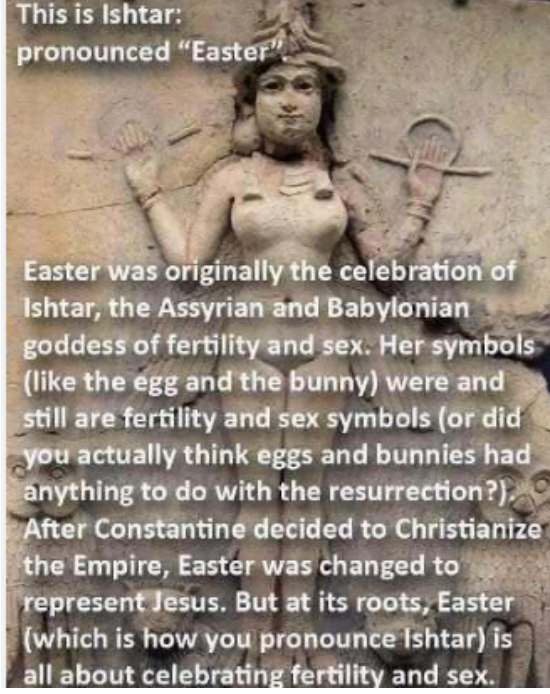How did chocolate eggs and bunnies come to be associated with the celebration of Christ’s resurrection? We have these customs because like Christmas Easter was originally a pagan holiday. As Christianity grew in acceptance many paganism practices and rituals were incorporated into Christian celebrations like Easter.
Rome which was the center of the world at the time saw a rise in Christianity around the middle of the third century. Emperor Constantine stopped the ongoing persecution of Christians in 312 after converting to Christianity. But he was aware that just because he had become Christian pagans would still continue to practice their rituals and traditions. So he began gradually incorporating existing paganism into Christian celebrations.
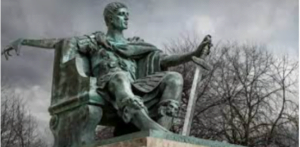
Constantine the Great the first Christian Emperor.
The Council of Nicaea a church council had decided that Easter should be observed on the Sunday following the first full moon following the spring equinox in 325 AD. Thus Easter Sunday was established and images of rebirth and renewal in nature began to be linked to Christ’s resurrection.
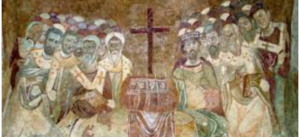
The Council of Nicaea
The Jewish festival of Passover which falls around the time of the spring equinox is where the Easter holiday got its name in the majority of Europe. Easter is therefore known as Pascha in Greece Pasqua in Italy Paques in France and Paaske in Denmark.
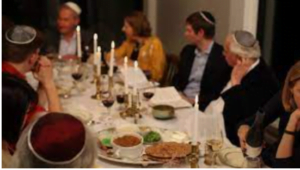
But in Germany and English-speaking countries like England Easter took its name from the pagan goddess Eostre – the goddess of spring and fertility. It is the pagan fertility goddess of humans and crops.
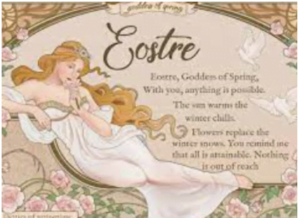
In the book “Sacred Celebrations” by Glennie Kindred one reads “Oestre the Goddess of Light brings fertility with the spring. This is the root of the word oestrus the time of an animal’s sexual cycle when it is fertile and oestrogen is the hormone stimulating ovulations. The Church overlaid this festival with Easter and its theme of rebirth and resurrection from death. Its timing is based on the old lunar calendar: the first Sunday after the first full moon after the spring equinox formerly the pregnant phase of Oestre passing into the fertile season.”
Only Bede’s work from the eighth century “The Reckoning of Time” mentions Oestre. Bede claims that the pagan Anglo-Saxons held feasts in honor of Oestre during Eosturmonab (the equivalent of April) but that by his time this tradition had vanished and been replaced by the Christian Paschal month which commemorates Jesus’ resurrection.
Since the establishment of Germanic philology in the 19th century by scholar Jacob Grimm and others the subject of a goddess called Austro(n) in the Proto-Germanic language has been extensively studied through linguistic reconstruction.
Due to the fact that Proto-Indo-European is the ancestor of the Germanic languages historical linguists have linked the name to the Proto-Indo-European dawn goddess Hewsos who may be the source of the common Germanic deity that gave rise to the Old English Eostre and the Old High German Ostara. In addition scholars have connected the goddess’ name to a number of Germanic given names a number of place names in England and more than 150 inscriptions from the second century that mention the matronae Austriahenae. These inscriptions were found in 1958.
Another research associated the word “Easter” descendance from the goddess “Ishtar” pronounced “Easter”. She is called the Queen of Heaven by the people of ancient Mesopotamia (modern Iraq) and was the most important female deity in their pantheon. Ishtar’s primary legacy as a fertility symbol comes from Sumerian mythology but she has since developed into a more complex figure who is surrounded in myth by death and disaster. She is a goddess of contradictory meanings and forces such as fire and fire-quenching joy and tears fair play and hostility. The planet Venus is associated with the Akkadian Ishtar who is also and to a greater extent an astral deity. She forms a secondary astral triad with the sun god Shamash and the moon god Sin. Her emblem in this manifestation is a circled star with six eight or sixteen rays. Ishtar was the patroness of the alehouse and the goddess of Venus who took pleasure in sensual sex. Her cult worship most likely included prostitution in temples. She was extremely well-liked throughout the ancient Middle East and in many places of worship she probably supplanted many local deities. She possessed the abilities of An Enlil and Enki and was referred to as the Queen of the Universe in later myth.


